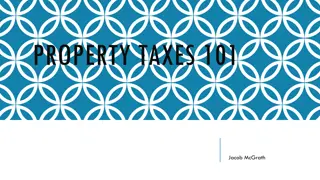Understanding Ad Valorem Taxes and Property Categories
Ad valorem taxes are levied based on property value, with different classes for taxation depending on the type of property. Real property is categorized into urban, rural, suburban, and assessed as of January 1st for the tax year. The taxation formula includes true value, assessment ratio, and millage rate.
Download Presentation

Please find below an Image/Link to download the presentation.
The content on the website is provided AS IS for your information and personal use only. It may not be sold, licensed, or shared on other websites without obtaining consent from the author. Download presentation by click this link. If you encounter any issues during the download, it is possible that the publisher has removed the file from their server.
E N D
Presentation Transcript
Define Ad Valorem The phrase ad valorem is Latin for according to value
What is Taxed Section 27-35-4 Class I Property: Single Family Owner Occupied Residential (10% of true value) Class II Property: All Real Property that is not Class I (15% of true value) Class III Property: Business Property furniture and fixtures; inventory (15% of true value) Required to be annually appraised at true value
What is Taxed (cont.) Section 27-35-4 Class IV Property Public Utilities (30% of true value) Class V Property Motor Vehicles cars, trucks, motor homes, mobile homes (30% of true value)
Real Property Categories Urban Land Heavily populated areas within the corporate limits of a city where buildings are concentrated and land ownership is in small parcels Principal uses are residential, commercial, and industrial Rural Land Less populated areas outside the city limits Rural land ownership is usually in large acreage tracts Principal uses are agricultural and residential
Real Property Categories (cont.) Suburban Land Fringe areas lying between urban and rural categories. Generally lying outside the corporate limits of a city, but not remote from concentrated population areas Area into which new residential subdivision, shopping centers, and industrial parks are developing and growing
Real Property Categories (cont.) Suburban Land Fringe area that is no longer urban or rural but rather a little of each Principal uses are for the most part the same as those of urban land Ownership and assessment of real property is as of January 1stof the tax year and payable the next year Example: Taxable: January 1, 2010 Payable: December 26, 2010 -- February 1, 2011
How Are These Classes Taxed? Basic Formula True Value x % (Ratio set by law) Assessed Value x Millage Rate Gross Taxes
What is a Mill & How is it Calculated? A mill is a unit used in calculating money but is not a coin. A mill is tenth of a penny or a thousand of a dollar. A tenth of one dollar or a dime is written $.10 A hundredth of one dollar or a penny is written $.01 One mill is a thousand of one dollar and is written $.001
Calculation Example A Class Two Property has a true value of $75,000 and is in a Taxing District in which the Tax Levy is 117.72 Mills. Calculate the Tax Bill. 117.72 Mills = $.11772 True Value = $75,000 Class 2 Ratio = x 0.15 Assessed Value = $ 11,250 Mill Rate = x 0.11772 Tax Bill = $ 1,324.35
Homestead Exemption Section 27-33-67 (1) (Regular Homestead) Homeowner under sixty-five (65) years of age on January 1 of the year for which the exemption is claimed, and who is not totally disabled shall be exempt from ad valorem taxes in the amount prescribed in Section 27-33-75 One-half (1/2) of the exemption allowed shall be from taxes levied for school district purposes and one-half shall be from taxies levied for county general fund Section 27-33-75 Regular Homestead Exemption Table
Reg. Homestead $7,500 Table Assessed Value of Homestead $ Credit $1 $150 $6 $151 $300 $12 $301 $450 $18 $451 $600 $24 $601 $750 $30 $751 $900 $36 $901 $1,050 $42 $1,051 $1,200 $48 $1,201 $1,350 $54 $1,351 $1,500 $60 $1,351 $1,650 $66 $1,501 $1,800 $72 $1,651 $1,950 $78 $1,801 $2,100 $84 $1,951 $2,250 $90
Assessed Value of Homestead $ Credit $2,101 $2,400 $96 $2,251 $2,550 $102 $2,401 $2,700 $108 $2,551 $2,850 $114 $2,701 $3,000 $120 $2,851 $3,150 $126 $3,001 $3,300 $132 $3,151 $3,450 $138 $3,301 $3,600 $144 $3,451 $3,750 $150 $3,601 $3,900 $156 $3,751 $4,050 $162 $3,901 $4,200 $168 $4,051 $4,350 $174 $4,201 $4,500 $180 $4,351 $4,650 $186 $4,501 $4,800 $192 $4,801 $4,950 $198 $4,951 $5,100 $204 $5,101 $5,250 $210
Assessed Value of Homestead $ Credit $5,251 $5,400 $216 $5,401 $5,550 $222 $5,551 $5,700 $228 $5,701 $5,850 $234 $5,851 $6,000 $240 $6,001 $6,150 $246 $6,151 $6,300 $252 $6,301 $6,450 $258 $6,451 $6,600 $264 $6,601 $6,750 $270 $6,751 $6,900 $276 $6,901 $7,050 $282 $7,051 $7,200 $288 $7,201 $7,350 $294 $7,351 $7,500 $300
Example Regular Homestead City School County Total Tax True Value Class I 100,000 100,000 100,000 100,000 Ratio .10 .10 .10 .10 Assessed Value 10,000 10,000 10,000 10,000 Millage Rate .025 .050 .050 .125 Gross Tax 250 500 500 1250 Homestead (0) (150) (150) (300) Net Tax Due 250 350 350 950
Homestead Exemption (cont.) Section 27-33-67 (2) (Special Homestead) Each qualified homeowner who has reached sixty- five (65) years of age on or before January 1 of the year for which the exemption is claimed or who is totally disable as herein defined shall be exempt from ad valorem taxes for up to $7,500 in assessed value
Example Special Homestead City School County Total True Value Class I 100,000 100,000 100,000 100,000 Ratio .10 .10 .10 .10 Assessed Value 10,000 10,000 10,000 10,000 Millage Rate .025 .050 .050 .125 Gross Tax 250 500 500 1250 Homestead - Special (187.50) (375) (375) (937.50) Net Tax Due 62.50 125 125 312.50
Example No Homestead (Class II Property) City School County Total True Value Class II 100,000 100,000 100,000 100,000 Ratio .15 .15 .15 .15 Assessed Value 15,000 15,000 15,000 15,000 Millage Rate .025 .050 .050 .125 Gross Tax 375 750 750 1,875 Homestead (0) (0) (0) (0) Net Tax Due 375 750 750 1,875
Millage Assessed Value x Millage = Budget Request for Taxes Therefore Millage = Budget Request Assessed Value
Millage Example Assume Budget = $4,000,000 $4,000,000 (Budget) Millage = $100,000,000 (Assessed Value) Millage = .040 or 40 Mills
Reimbursement of Tax Loss Section 27-33-77 Tax Losses sustained by local governments because of exemption granted to homeowners shall be reimbursed up to amount of the actual exemption allowed, not to exceed $200.00 per qualified applicant. This reimbursement is payable in March and September
Contact Information Sumner Davis Center for Government & Community Development MSU Extension Service Box 9643 MS State, MS 39762 662-325-3141 sumner.davis@msstate.edu























